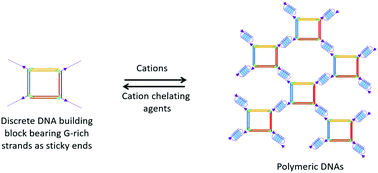Our official English website, www.x-mol.net, welcomes your
feedback! (Note: you will need to create a separate account there.)
Reversible reconfiguration of high-order DNA nanostructures by employing G-quartet toeholds as adhesive units.
Nanoscale ( IF 5.8 ) Pub Date : 2020-01-09 , DOI: 10.1039/c9nr08070h Miu Shan Chan 1 , Hoi Man Leung 1 , Sze Wing Wong 1 , Zihong Lin 2 , Qi Gao 2 , Tristan Juin Han Chang 1 , King Wai Chiu Lai 2 , Pik Kwan Lo 3
Nanoscale ( IF 5.8 ) Pub Date : 2020-01-09 , DOI: 10.1039/c9nr08070h Miu Shan Chan 1 , Hoi Man Leung 1 , Sze Wing Wong 1 , Zihong Lin 2 , Qi Gao 2 , Tristan Juin Han Chang 1 , King Wai Chiu Lai 2 , Pik Kwan Lo 3
Affiliation

|
G-quadruplex structures are becoming useful alternative interaction modules for the assembly of DNA nanomaterials because of their unique inducibility by cations. In this study, we demonstrated a new strategy for the assembly of polymeric DNA nanoarchitectures in the presence of cations, such as K+ and Na+, by employing G-quartet toeholds at the edges of discrete mini-square DNA building blocks as adhesive units. In comparison with the Watson-Crick base-paired duplex linkers, G-quadruplex arrays embedded in the self-assembled DNA system exhibit higher thermal stability. The morphology of these doughnut-shaped or spherical-shaped DNA nanostructures is highly regulated by the orientation of the folded G-quadruplexes either in parallel or antiparallel orientation in response to different cations. Furthermore, this G-quadruplex-mediated assembly strategy is able to manipulate the cycling of DNA assemblies between discrete and polymeric states by means of introducing cations and chelating agents sequentially. This property enables the reversible manipulation of the DNA-based nanosystems for at least 4 cycles. The G-quadruplex array embedded in this self-assembled DNA system can become a scaffold for functional molecules, as a number of organic molecules and proteins exhibit specific binding to these G-quadruplex structures. Besides, embedded G-quadruplexes are also considered as functional components of nanoscale electronic materials due to their electron transport through the stacked orientation of the G-quartet. Therefore, this work is an important step towards obtaining reversible, responsive G-quadruplex-induced DNA-based nanomaterials with versatile functionalities which will be highly useful in further electronic, biomedical and drug-delivery applications.
中文翻译:

通过使用G四重奏脚趾作为黏着剂单元,可逆重组高阶DNA纳米结构。
G-四链体结构由于其独特的阳离子诱导性,正成为用于组装DNA纳米材料的有用的替代相互作用模块。在这项研究中,我们展示了一种新的策略,用于在阳离子(例如K +和Na +)存在的情况下,通过在离散的迷你正方形DNA构建块的边缘使用G四重奏脚尖作为粘合单元,来组装聚合物DNA纳米结构。与沃森-克里克碱基配对的双链体接头相比,嵌入自组装DNA系统中的G-四链体阵列表现出更高的热稳定性。这些甜甜圈形或球形DNA纳米结构的形态受到折叠的G-四链体响应不同阳离子的平行或反平行方向的高度调节。此外,这种G-四链体介导的组装策略能够通过顺序引入阳离子和螯合剂来控制DNA组装在离散状态和聚合状态之间的循环。该特性使基于DNA的纳米系统可逆操作至少4个循环。嵌入此自组装DNA系统中的G-四链体阵列可以成为功能分子的支架,因为许多有机分子和蛋白质都表现出与这些G-四链体结构的特异性结合。此外,由于嵌入的G-四链体通过G-四方体的堆叠方向进行电子传输,因此也被认为是纳米级电子材料的功能组件。因此,这项工作是迈向可逆的重要一步,
更新日期:2020-01-09
中文翻译:

通过使用G四重奏脚趾作为黏着剂单元,可逆重组高阶DNA纳米结构。
G-四链体结构由于其独特的阳离子诱导性,正成为用于组装DNA纳米材料的有用的替代相互作用模块。在这项研究中,我们展示了一种新的策略,用于在阳离子(例如K +和Na +)存在的情况下,通过在离散的迷你正方形DNA构建块的边缘使用G四重奏脚尖作为粘合单元,来组装聚合物DNA纳米结构。与沃森-克里克碱基配对的双链体接头相比,嵌入自组装DNA系统中的G-四链体阵列表现出更高的热稳定性。这些甜甜圈形或球形DNA纳米结构的形态受到折叠的G-四链体响应不同阳离子的平行或反平行方向的高度调节。此外,这种G-四链体介导的组装策略能够通过顺序引入阳离子和螯合剂来控制DNA组装在离散状态和聚合状态之间的循环。该特性使基于DNA的纳米系统可逆操作至少4个循环。嵌入此自组装DNA系统中的G-四链体阵列可以成为功能分子的支架,因为许多有机分子和蛋白质都表现出与这些G-四链体结构的特异性结合。此外,由于嵌入的G-四链体通过G-四方体的堆叠方向进行电子传输,因此也被认为是纳米级电子材料的功能组件。因此,这项工作是迈向可逆的重要一步,











































 京公网安备 11010802027423号
京公网安备 11010802027423号